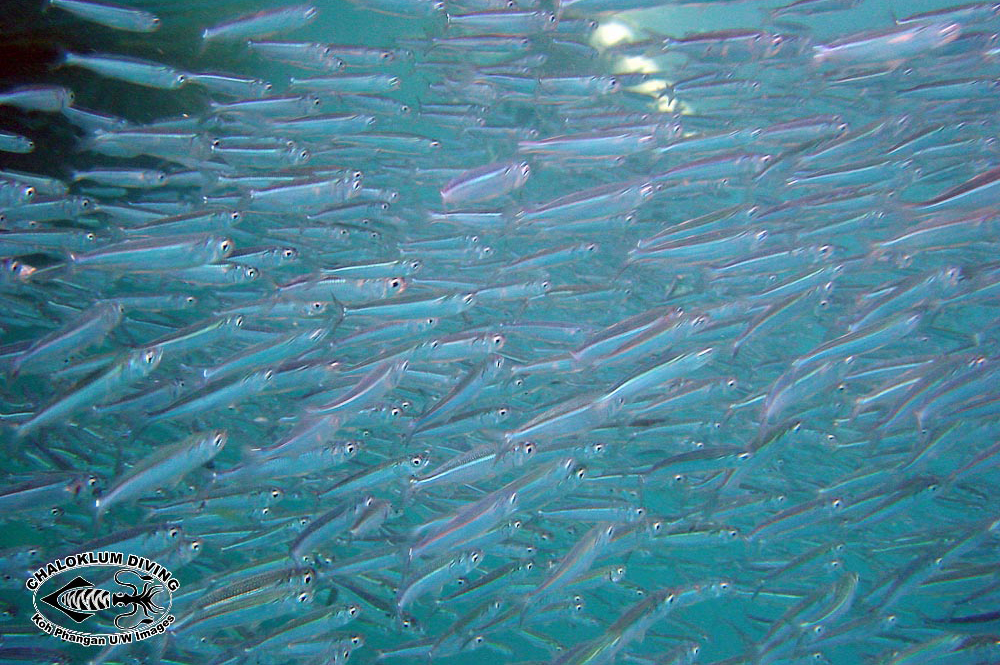Indian Anchovy, Stolephorus indicus (Hasselt 1823)

A school of Indian Anchovy, Stolephorus indicus - Thailand. Source: Chaloklum Diving / EOL. License: CC By Attribution
Summary:
A pale translucent fleshy brown, with a silver midlateral stripe, no dark pigment lines on the back between the head and the dorsal-fin origin, and 2–6 (mostly 4) small needle-like scutes between the pectoral and pelvic-fin bases.
Cite this page as:
Bray, D.J. 2021, Stolephorus indicus in Fishes of Australia, accessed 01 Jul 2025, https://fishesofaustralia.net.au/Home/species/2074
Indian Anchovy, Stolephorus indicus (Hasselt 1823)
More Info
|
Distribution |
Northwest Shelf, Western Australia around the tropcal north to NE of Rules Beach, southern Queensland. Elsewhere the species is widespread in the tropical, Indo-west-central Pacific. Forms schools in coastal waters, entering the estuarine parts of rivers. |
|
Features |
Gill rakers (lower) 20-28; 2–6 (mostly 4) small needle-like scutes between pectoral and pelvic-fin bases; Posterior border of preopercle convex, rounded; tip of maxilla short, not reaching anterior border of preopercle; pelvic-fin tips not reaching to dorsal-fin origin; post-pelvic scutes absent. |
|
Fisheries |
Commercially fished, and taken as by-catch in parts of its range. The species is common in subsistence and artisanal fisheries throughout its range, and is used as bait in South Pacific tuna fisheries. |
|
Species Citation |
Engraulis indicus van Hasselt 1823, Algemeene Konst- en Letter-Bode 1(21): 329.Type locality: Vishakhapatnam (as Vizagapatam), India; Java, Indonesia. |
|
Author |
Bray, D.J. 2021 |
|
Resources |
Indian Anchovy, Stolephorus indicus (Hasselt 1823)
References
Allen, G.R. 1997. Marine Fishes of Tropical Australia and South-east Asia. Perth : Western Australian Museum 292 pp. 106 pls.
Hata, H., Lavoué, S. & Motomura, H. 2021. Taxonomic status of nominal species of the anchovy genus Stolephorus previously regarded as synonyms of Stolephorus commersonnii Lacepède 1803 and Stolephorus indicus (van Hasselt 1823), and descriptions of three new species (Clupeiformes: Engraulidae). Ichthyological Research 68: 327–372. https://doi.org/10.1007/s10228-020-00792-0
Larson, H.K., Williams, R.S. & Hammer, M.P. 2013. An annotated checklist of the fishes of the Northern Territory, Australia. Zootaxa 3696(1): 1-293
Russell, B.C. & Houston, W. 1989. Offshore fishes of the Arafura Sea. The Beagle, Records of the Museums and Art Galleries of the Northern Territory 6(1): 69-84
Sainsbury, K.J., Kailola, P.J. & Leyland, G.G. 1984. Continental Shelf Fishes of Northern and North-Western Australia. Canberra : Fisheries Information Service 375 pp. figs & pls.
Santos, M., Gapuz, A.V., Lanzuela, N., Buccat, F.G.A., Belga, P.B., Lopez, G., Villarao, M.C., Doyola, M.C., Deligero, R., Alcantara, M., Gatlabayan, L.V., Tambihasan, A.M., Villanueva, J.A. & Parido, L. 2017. Stolephorus indicus (errata version published in 2018). The IUCN Red List of Threatened Species 2017: e.T196318A136954531. https://dx.doi.org/10.2305/IUCN.UK.2017-3.RLTS.T196318A2444959.en. Downloaded on 10 November 2021.
van Hasselt, J.C. van 1823. Uittreksel uit een' brief van Dr. J.C. van Hasselt, aan den Heer C.J. Temminck. Algemeene Konst- en Letter-Bode 1(21): 329-331
Whitehead, P.J.P., Nelson, G.J. & Wongratana, T. 1988. FAO Species Catalogue. Clupeoid fishes of the world (Suborder Clupeoidei). An annotated and illustrated catalogue of the herrings, sardines, pilchards, sprats, anchovies and wolf-herrings. Engraulididae. FAO Fisheries Synopsis. No. 125 Vol. 7 Pt 2. 305-579 pp.
Wongratana, T., Munroe, T.A. & Nizinski, M.S. 1999. Family Engraulidae. pp. 1698-1753 in Carpenter, K.E. & Niem, V.H. (eds). The Living Marine Resources of the Western Central Pacific. FAO Species Identification Guide for Fisheries Purposes. Rome : FAO Vol. 3 pp. 1397-2068.




